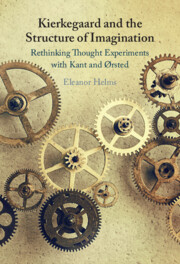Book contents
- Kierkegaard and the Structure of Imagination
- Kierkegaard and the Structure of Imagination
- Copyright page
- Contents
- Acknowledgments
- Abbreviations
- Introduction
- Part I The Origins of “Thought Experiment” in Kant and Ørsted
- Chapter 1 Thought Experiments as Tools of Cognition
- Chapter 2 How Thought Experiments Work
- Chapter 3 Ørsted, Mach, and the History of Thought Experiment
- Chapter 4 Empiricism and Kantian Accounts of Thought Experiment
- Chapter 5 Rationalism and the Question of Intellectual Intuition
- Part II A Kantian Account of Thought Experiment
- Part III Kierkegaard and the Concept of Thought Experiment
- Conclusion
- Bibliography
- Index
Chapter 3 - Ørsted, Mach, and the History of Thought Experiment
from Part I - The Origins of “Thought Experiment” in Kant and Ørsted
Published online by Cambridge University Press: 26 September 2025
- Kierkegaard and the Structure of Imagination
- Kierkegaard and the Structure of Imagination
- Copyright page
- Contents
- Acknowledgments
- Abbreviations
- Introduction
- Part I The Origins of “Thought Experiment” in Kant and Ørsted
- Chapter 1 Thought Experiments as Tools of Cognition
- Chapter 2 How Thought Experiments Work
- Chapter 3 Ørsted, Mach, and the History of Thought Experiment
- Chapter 4 Empiricism and Kantian Accounts of Thought Experiment
- Chapter 5 Rationalism and the Question of Intellectual Intuition
- Part II A Kantian Account of Thought Experiment
- Part III Kierkegaard and the Concept of Thought Experiment
- Conclusion
- Bibliography
- Index
Summary
This chapter lays out the ways in which Hans Christian Ørsted (1777–1851) influenced the development of the concept of thought experiment. Ernst Mach (1838–1916) is currently more often credited with laying the foundations of contemporary views, and he is sometimes thought to have been little (if at all) influenced by Ørsted. Against these standard accounts, I will show that Ørsted’s and Mach’s descriptions have key features in common. Both thinkers hold that thought experiments: (1) are a method of variation, (2) require the experimenter’s free activity, and (3) are useful in educational contexts for guiding students to arrive at certain conclusions on their own (i.e., to genuinely appropriate new concepts). The process of variation is guided by the search for invariants, some of which do not directly appear in experience. Since it is important that teachers and students be able to bring the same ideal objects to mind, thought experiments play a key role for both Ørsted and Mach in math education. While Ørsted’s emphasis on the role of thought experiments in math has been proposed as a reason why his descriptions are not relevant for contemporary use of thought experiments, I will show how their role in mathematical thinking – stemming from Kant’s descriptions of the method of construction in geometry – are part of a wider account of thought experiments that encompasses their role in the sciences and also philosophy.
Information
- Type
- Chapter
- Information
- Kierkegaard and the Structure of ImaginationRethinking Thought Experiments with Kant and Ørsted, pp. 47 - 62Publisher: Cambridge University PressPrint publication year: 2025
Accessibility standard: Inaccessible, or known limited accessibility
Why this information is here
This section outlines the accessibility features of this content - including support for screen readers, full keyboard navigation and high-contrast display options. This may not be relevant for you.Accessibility Information
Content Navigation
Allows you to navigate directly to chapters, sections, or non‐text items through a linked table of contents, reducing the need for extensive scrolling.
Provides an interactive index, letting you go straight to where a term or subject appears in the text without manual searching.
Reading Order & Textual Equivalents
You will encounter all content (including footnotes, captions, etc.) in a clear, sequential flow, making it easier to follow with assistive tools like screen readers.
You get more than just short alt text: you have comprehensive text equivalents, transcripts, captions, or audio descriptions for substantial non‐text content, which is especially helpful for complex visuals or multimedia.
Visual Accessibility
You will still understand key ideas or prompts without relying solely on colour, which is especially helpful if you have colour vision deficiencies.
You benefit from high‐contrast text, which improves legibility if you have low vision or if you are reading in less‐than‐ideal lighting conditions.
